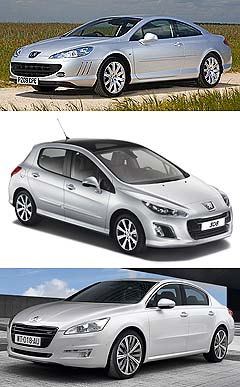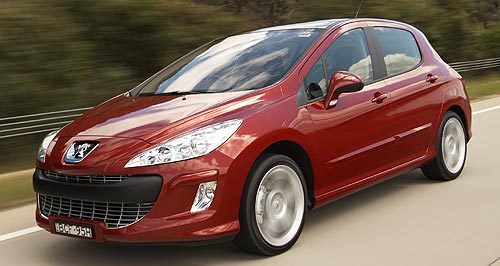Make / Model Search
New models - Peugeot - 308Peugeot goes Euro 5 for diesel 308Poke not smoke: Cleaner Euro 5 diesels in Peugeot’s 308 have a side benefit of producing more power and torque. More power and torque for diesel 308s after Peugeot’s EU5 upgrade17 Feb 2011 PEUGEOT has dropped the aged 407 mid-sizer from its price lists and applied modifications to diesel engines in the 308 small car range to make them Euro 5 emissions-compliant. A side-effect of the emissions tweaks brings power and torque increases of up to 20 per cent and 12.5 per cent respectively – enough to shave almost three seconds off the quoted 0-100km/h time on some variants. This completes Peugeot’s transition to a fully Euro 5-compliant Australian line-up ahead of a Geneva debut for the heavily revised 308 – which will also be displayed alongside an all-new, mid-sized 508 at the Melbourne motor show in July. 308s powered by the 1.6-litre HDi diesel engine gain 2kW and 30Nm, raising output to 82kW and 270Nm while the 2.0-litre HDi gets a healthy hike of 20kW to 120kW and a torque upgrade from 320Nm to 340Nm. The difference is most noticeable on the Touring wagon, translating into a respectable 10.3 second dash to 100km/h for 2.0-litre diesel, down from a leisurely 13.2 seconds. The 1.6 diesel Touring also now posts a decent 11.9 seconds against the plodding 14.2 of the old Euro 4 version.  From top: Peugeot 407 coupe, Geneva 2011 Peugeot 308 update and Peugeot 508. From top: Peugeot 407 coupe, Geneva 2011 Peugeot 308 update and Peugeot 508.In a range reshuffle the XTS, former flagship of the 308 hatch range has been deleted, as have base XS-spec 308 Tourings with the naturally-aspirated 1.6-litre petrol engine and 2.0-litre diesel manual – meaning entry to the 308 Touring range now starts at $35,490 for the 2.0-litre HDi auto. Going all-out with a top-spec 308CC in XTS trim now costs $500 more, at $58,990. With the new-look 308 due to arrive in local showrooms around September, it seems strange for Peugeot to roll out an engine upgrade so late in the current car’s life. However, Euro 5 compliancy, which restricts vehicle emissions of carbon monoxide, hydrocarbons, oxides of nitrogen and particulate matter – but not CO2 – became mandatory in Europe at the beginning of this year, forcing manufacturers like Peugeot to fall into line. Euro 4 compliance in Australia became compulsory for all passenger vehicles at the start of July 2010. As GoAuto has reported, in January last year the Rudd government issued a draft report prepared by the transport department recommending the Euro 5 emissions standard be introduced in Australia between 2012 and 2014, but a date is yet to be confirmed. The report also recommends a move to the even tougher Euro 6 regulations from 2016. The FCAI hit back, saying the local automotive industry had “very significant concern” about the proposal, while Ford Australia also revealed that engineering its Geelong-built six-cylinder engine to meet the Euro 5 standard would be difficult. The 308 is by far Peugeot’s best seller, accounting for 55 per cent of its 5649 cars sold last year. Overall, Peugeot sales were down 1.7 per cent on 2009’s result and the French manufacturer also had a poor start to 2011, selling 342 cars in January against 422 for the same time last year, a drop of 19 per cent.
 Read moreAll new models Alfa Romeo Alfa Romeo Abarth Abarth Alpine Alpine Alpina Alpina Audi Audi Aston Martin Aston Martin BMW BMW Bentley Bentley Chery Chery Brabham Brabham Chrysler Chrysler Chevrolet Chevrolet Cupra Cupra Citroen Citroen DS DS Dodge Dodge Fiat Fiat Ferrari Ferrari Foton Foton Ford Ford Great Wall Great Wall FPV FPV Haval Haval GWM GWM Honda Honda Holden Holden Hyundai Hyundai HSV HSV Isuzu Isuzu Infiniti Infiniti Jeep Jeep Jaguar Jaguar Lamborghini Lamborghini Kia Kia LDV LDV Land Rover Land Rover Lotus Lotus Lexus Lexus Maserati Maserati Mahindra Mahindra McLaren McLaren Mazda Mazda Mercedes-Benz Mercedes-Benz Mercedes-AMG Mercedes-AMG Mini Mini MG MG Nissan Nissan Mitsubishi Mitsubishi Pagani Pagani Opel Opel Porsche Porsche Peugeot Peugeot Ram Ram Proton Proton Rolls-Royce Rolls-Royce Renault Renault Saab Saab Rover Rover Smart Smart Skoda Skoda Subaru Subaru SsangYong SsangYong Tesla Tesla Suzuki Suzuki Toyota Toyota Volvo Volvo308 pricing
Motor industry news |
|
||||||||||||||||||||||||||||||||||||||||||||||||||||||||











Facebook Twitter Instagram